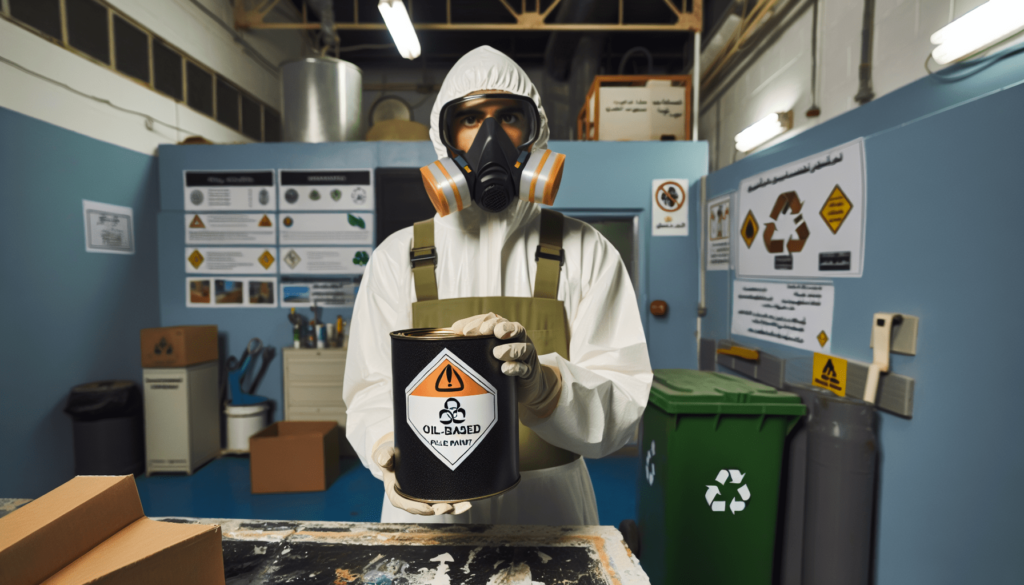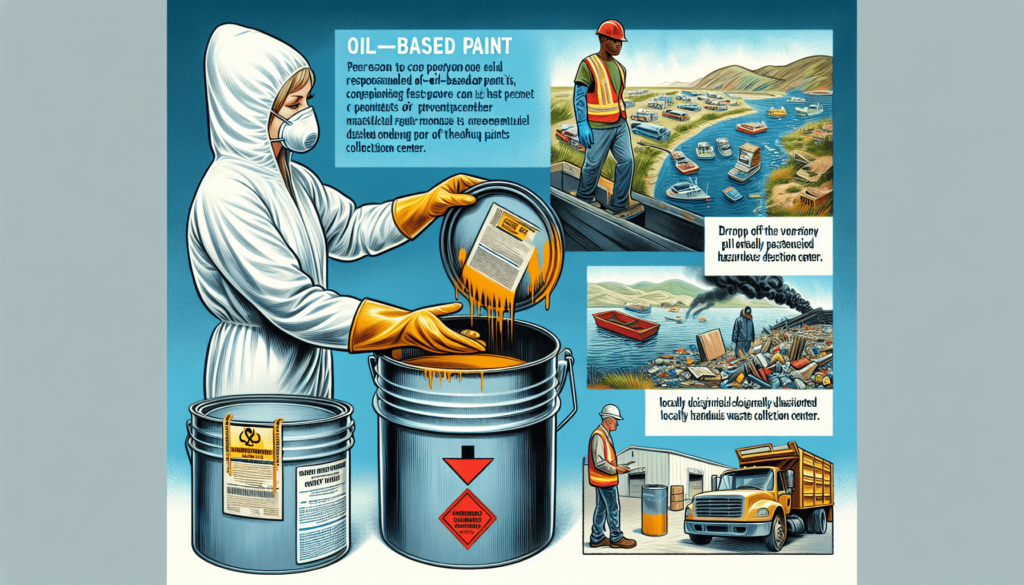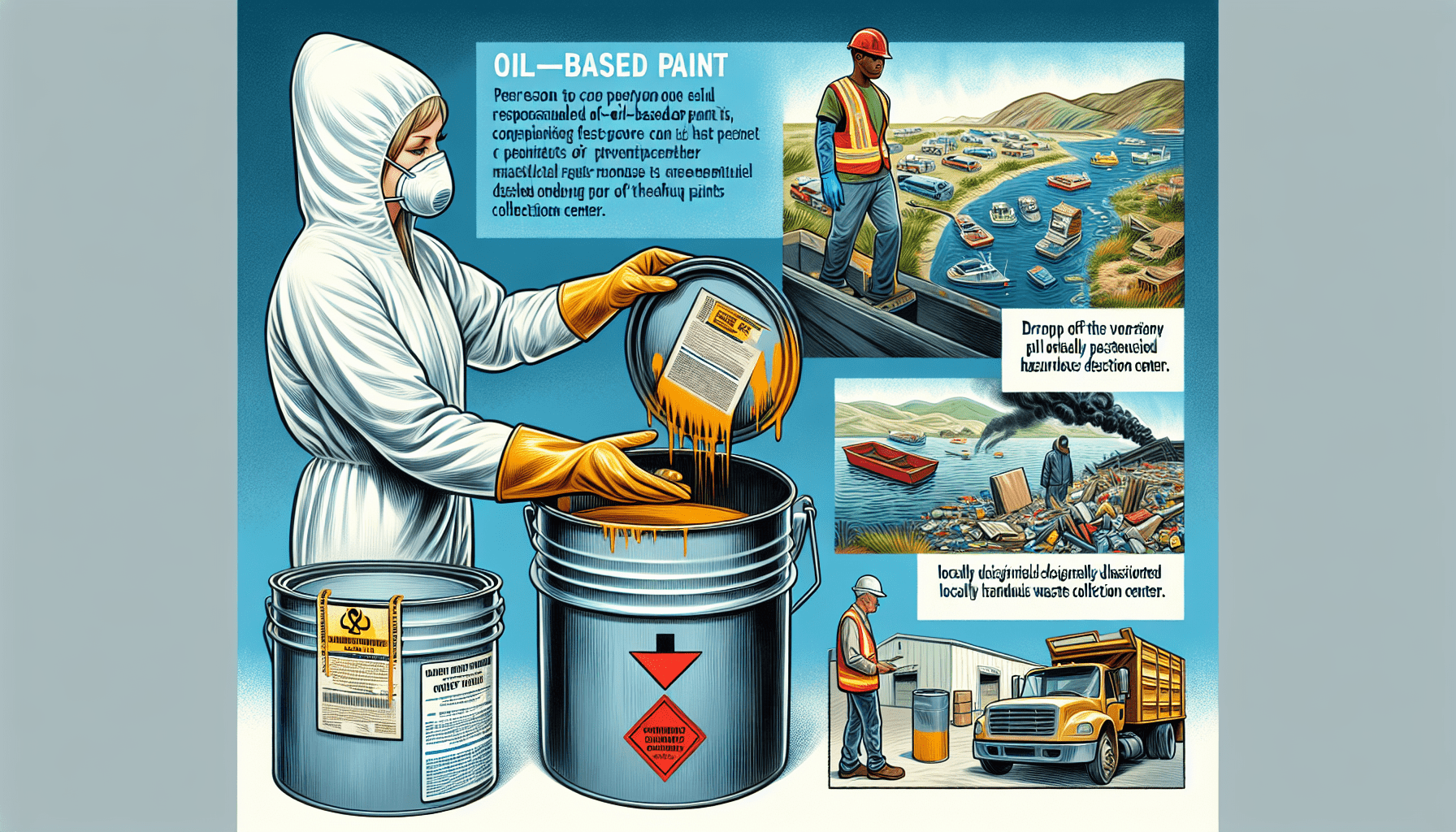Navigating the proper disposal methods for hazardous materials such as oil-based paint can be a daunting task. The article titled, “How Do You Dispose Of Oil Based Paint” provides comprehensive insights into safe, legal, and environmentally-friendly procedures for disposing of oil-based paint. You will find detailed, step-by-step instructions, along with the reasoning behind why special care is necessary when it comes to these types of materials. This essential guide ensures you handle your leftover paint responsibly, adhering to both safety and environmental guidelines.

What is oil-based paint?
Definition
Oil-based paint is a type of paint formulated with oil, typically linseed oil, as its main binder. The oil is used as a carrier to hold and maintain the pigments in the paint together in a unified composition. This particular type of paint is known for its durability and rich, glossy finish.
Composition
The fundamental components of oil-based paints include oils (the binder), solvents, pigments, and additives. The oils in the paint allow it to spread smoothly, produce a high-gloss finish and show resistance to wear and tear. Solvents, usually mineral spirits or turpentine, are added to make the paint easier to work with, while pigments give the paint its distinctive color. Lastly, additives are incorporated to enhance certain properties like drying time, flow, and durability.
Why is proper disposal of oil-based paint important?
Environmental hazards
Improper disposal of oil-based paint can lead to serious environmental consequences. As an example, pouring paint down the drain or in open ground can lead to soil and water contamination. This contamination might be harmful to plants, aquatic life, animals, and even humans through the food chain. Furthermore, allowing paint to evaporate into the air contributes to ozone layer depletion and air pollution.
Legal regulations
Complying with legal regulations is another reason why proper oil-based paint disposal needs to be emphasized. In many countries and states, improperly tossing oil-based paints into domestic trash or pouring it down the drain is illegal, leading to heavy fines or penalties if you are caught and convicted.
Check the label for disposal instructions
To ensure proper oil-based paint disposal, one of the first steps you should take is to check the label for instructions. The label oftentimes includes useful guidelines on how you can safely discard any surplus paint. Furthermore, it may provide recommendations on paint storage in case you wish to save it for later use.
Donate or give away unused paint if possible
Local community organizations
Donating isn’t merely a way to dispose of oil-based paint, it’s also a good opportunity to contribute to local community organizations. Many art groups, schools, and non-profit organizations can put your spare paint to good use. Be sure to check with them before donating to ensure your paint is suitable for their needs.
Online platforms
Additionally, you can use online marketplaces to give away your unused paint. Sites like Freecycle or Craigslist can be ideal platforms to list free paint. Be transparent about the type and amount of paint you have to guarantee it finds a suitable new home.

Reuse or repurpose the paint
Touch-ups and small projects
The easiest method to dispose of surplus paint is simply to reuse it. You can store it for future touch-ups or small painting projects. Oil-based paint is especially excellent for surfaces that need a sturdy finish or endure a lot of use, like doors, furniture, or trim.
Crafts and art projects
Repurposing your remaining oil-based paint for crafts and art projects is another viable option. Doing this will not only breathe new life into the paint, but it also promotes creativity and resourcefulness.
Dry out the paint for disposal
Step-by-step method
One common approach is to let the paint dry out before throwing it away. This method is best for smaller amounts of paint. Remove the lid and leave the can in a well-ventilated area away from children and pets. When thoroughly dry, dispose of in accordance with your local waste regulations.
Using cat litter or sawdust
For larger volumes of paint, using absorbent materials like cat litter or sawdust can help expedite the drying process. Begin by placing the absorbent material into the can until it soaks up the paint, following which the paint will begin to harden.
Contact local waste disposal facilities
Household hazardous waste collection
Many communities offer household hazardous waste collection events or facilities. They have the necessary equipment to handle and dispose of dangerous items like oil-based paint. These facilities are specially designed to prevent the harmful chemicals found in such items from contaminating the environment.
Landfill or transfer station
There may be specific regulations in place that govern the acceptance of dried out oil-based paint in landfills or transfer stations. Always contact these sites lawfully responsible for proper waste disposal beforehand to ascertain if they accept paint waste.
Hire professional disposal services
Hazardous waste disposal agencies
Hiring professional disposal agencies is an excellent option when dealing with large quantities of oil-based paint. These agencies are well-versed in the rules and regulations tied to disposing of hazardous waste and know how to adequately handle the task.
Paint recycling companies
Some companies specialize in recycling unused paint, helping to conserve resources while reducing environmental damage. Just ensure to verify that the firm you choose handles oil-based paint since not all companies do.
Tips to remember
Avoid pouring paint down the drain or in the trash
It’s critical to remember never to pour surplus paint down drains or toilets or directly into trash containers. This action is not only harmful to the environment but also illegal in many jurisdictions.
Store paint properly for future use
Lastly, if you plan to keep some paint for future use, store it correctly. By ensuring the lid is tightly sealed and storing the can in a cool, dry place, you can extend its shelf life.
Conclusion
While oil-based paint offers many product application benefits, incorrect disposal can lead to environmental damage and legal ramifications. As such, it’s crucial to be aware of the proper disposal methods, ranging from donation or repurposing to drying it out or employing professional disposal services, to protect yourself and our planet from unwanted harm. When it comes with it being an environmental or legal issue, each individual act of responsible disposal matters. Let’s make sure we act properly- our efforts will pave the way for a cleaner, safer environment for all.



